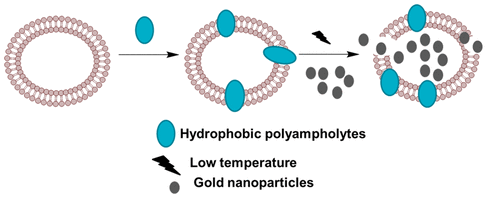Our official English website, www.x-mol.net, welcomes your
feedback! (Note: you will need to create a separate account there.)
Hydrophobic Polyampholytes and Nonfreezing Cold Temperature Stimulate Internalization of Au Nanoparticles to Zwitterionic Liposomes.
Langmuir ( IF 3.7 ) Pub Date : 2018-07-06 , DOI: 10.1021/acs.langmuir.8b00920 Sana Ahmed 1 , Kazuaki Matsumura 1 , Tsutomu Hamada 1
Langmuir ( IF 3.7 ) Pub Date : 2018-07-06 , DOI: 10.1021/acs.langmuir.8b00920 Sana Ahmed 1 , Kazuaki Matsumura 1 , Tsutomu Hamada 1
Affiliation

|
Nanomedicine relies on the effective internalization of nanoparticles combined with polymeric nanocarriers into living cells. Thus, exploration of internalization is essential for improving the efficacy of nanoparticle-based strategies in clinical practice. Here, we investigated the physicochemical internalization of gold nanoparticles (AuNPs) conjugated with hydrophobic polyampholytes into cell-sized liposomes at a low but nonfrozen temperature. The hydrophobic polyampholytes localized in the disordered phase of the membrane, and internalization of AuNPs was enhanced in the presence of hydrophobic polyampholytes together with incubation at -3 °C as compared to 25 °C. These results contribute toward a mechanistic understanding for developing a model nanomaterials-driven delivery system based on hydrophobic polyampholytes and low temperature.
中文翻译:

疏水性两性电解质和非冻结低温可刺激金纳米颗粒内化为两性离子脂质体。
纳米医学依赖于将纳米颗粒与聚合物纳米载体结合到活细胞中的有效内在化。因此,内在化的探索对于提高基于纳米粒子的策略在临床实践中的有效性至关重要。在这里,我们研究了在低温但不冻结的温度下,与疏水性两性电解质结合的金纳米颗粒(AuNPs)的理化内在化作用。疏水性多两性电解质位于膜的无序相中,并且与25°C相比,在疏水性多两性电解质的存在下以及在-3°C的孵育条件下,AuNP的内在化得以增强。这些结果有助于基于机理的理解,以开发基于疏水性两性电解质和低温的模型纳米材料驱动的递送系统。
更新日期:2018-06-24
中文翻译:

疏水性两性电解质和非冻结低温可刺激金纳米颗粒内化为两性离子脂质体。
纳米医学依赖于将纳米颗粒与聚合物纳米载体结合到活细胞中的有效内在化。因此,内在化的探索对于提高基于纳米粒子的策略在临床实践中的有效性至关重要。在这里,我们研究了在低温但不冻结的温度下,与疏水性两性电解质结合的金纳米颗粒(AuNPs)的理化内在化作用。疏水性多两性电解质位于膜的无序相中,并且与25°C相比,在疏水性多两性电解质的存在下以及在-3°C的孵育条件下,AuNP的内在化得以增强。这些结果有助于基于机理的理解,以开发基于疏水性两性电解质和低温的模型纳米材料驱动的递送系统。









































 京公网安备 11010802027423号
京公网安备 11010802027423号